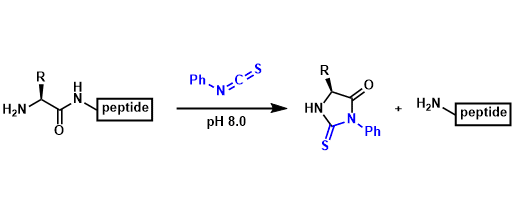- Generality
- Reagent Availability
- Experimental User Friendliness
- Contribution to Biochemistry
- Criteria #5
-
General Characteristics
The Edman degradation is a way to determine the primary structure of peptides. Phenyl isocyanate reacts with the N-terminus amino acid residue and only that residue is cleaved in phenyl thiohydantoin form. This procedure is repeated and the cleaved amino acids are analyzed one by one.
This method requires only a small amount of samples, but is usually limited to peptides of length up to 30 to 50 residues. It is incompatible with peptides containing unreactive N-terminus, such as those with a modified N-terminus and those in which the N-terminus residue is conformationally buried inside the molecule. Because secondary and tertiary structures have to be destroyed in advance, the information on those higher structures (such as the position of disulfide bonds) cannot be obtained.
-
General References
・Edman, P.; Hogfeldt, E.; Sillen, L. G.; Kinell, P.-O. Acta Chem. Scand. 1950, 4, 283. doi:10.3891/acta.chem.scand.04-0283
・Edman P.; Begg G. Eur. J. Biochem. 1967, 1, 80.
・Niall, H. D. Meth. Enzymol.1973, 27, 942. doi:10.1016/S0076-6879(73)27039-8
-
Reaction Mechanism

-
Video
-
Related Books
[amazonjs asin=”0896039757″ locale=”US” title=”Protein Sequencing Protocols (Methods in Molecular Biology)”]
-
External Links

